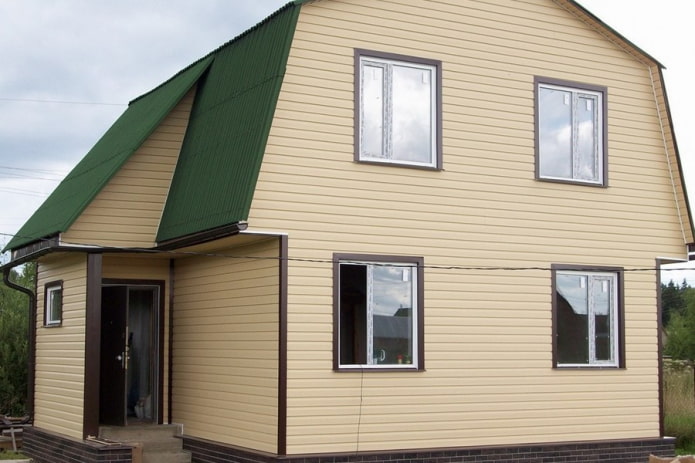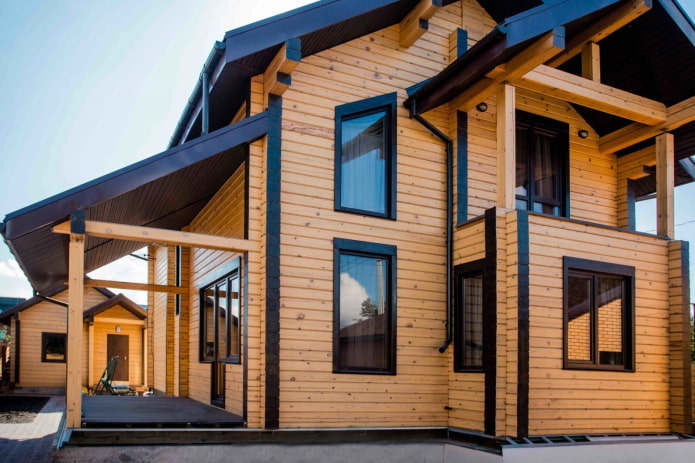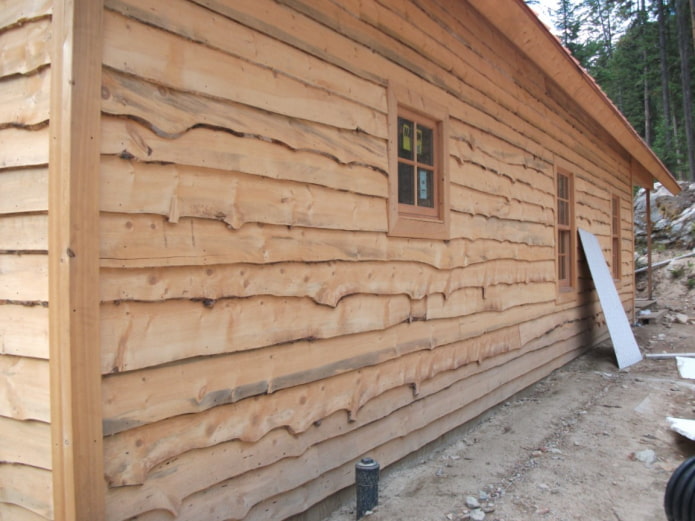Vinyl siding
Vinyl siding is essentially the same plastic panels for interior decoration, but in a different form. It is made of the same polyvinyl chloride (PVC), so the choice of colors, textures and designs is practically unlimited: the house can be calm blue, cheerful yellow or neutral beige. Sheathed in imitation of a ship's beam or block house.
Benefits vinyl siding:
- Low price... One three-meter panel, 20.5 cm wide will cost about 100-120 rubles, lamellas 3660 * 232 mm are a little more expensive - 150-250 rubles / piece.
- Attractive appearance... Usually the house is admired from a distance of at least 3 m, and from this point the "cheapness" of plastic will not be noticeable.
- Long service life... Unexpectedly, cheap PVC, subject to all installation requirements, will last up to 50 years, because, unlike metal or wood, it does not rust or rot.
- Ease of installation... Lightweight panels can be simply lifted to the desired height, they are attached to ordinary screws or clamps, do not require preliminary preparation, such as treatment with antiseptics.
Important! When calculating the cost, do not forget about the accessories - connecting elements, corners, fasteners.
disadvantages:
- Low impact resistance... The casing will break from an accidental moderate impact.
- Looks cheap up close... Still, you can't hide the "pedigree" - plastic is plastic.
- Makes sounds... If installed incorrectly, the siding will crackle and creak due to temperature changes.
- Requires additional insulation... It should also be taken into account when drawing up an expense plan.
Facade plaster
If the terms trowel and trowel are familiar to you, pay attention to facade plaster. The cost of a high-quality decorative dry mix starts from 700 rubles per 25 kg (this is enough to process 12 square meters), but you can also use a regular street one, giving it a texture with a trowel: its cost is half as much.
pros plasters:
- Environmental friendliness... It is logical to assume that gypsum or cement, even with impurities, is much safer than plastic.
- Vapor permeability... The walls will "breathe", which means the risk of fungal growth is reduced to zero.
- Variability... Choose a texture or create it, paint the composition or ready-made walls in the desired shade.
- Ease of care... The finished walls are easily cleaned of dirt, which means the house will always look neat. If the coating is cracked, it can always be "greased".
As such disadvantages there is no plaster for facades, but if you have never applied it, the process will seem incredibly complicated. But once you get used to it, the work will go!
Wood
Choosing a cheap, but environmentally friendly solution for the facade, many come to the tree. Moreover, there is plenty to choose from: a rounded block house, a laconic false beam, a stylish American lining, a ship board.
The cost of a raised beam is about 300 rubles for a board 300 * 20 cm, for a block house of the same size - 450-600 rubles.
Dignity wood cladding:
- Environmental friendliness... More natural material could not be imagined.
- Weather resistant... Wooden panels withstand temperature extremes, ultraviolet light, precipitation.
- Relatively light weight... You don't have to strengthen the foundation.
- Ease of installation... Even a beginner can handle it.
Of cons - complex preprocessing. Do you want the skin to retain its beauty and durability for many years? Treat boards with protective agents against fungus, rot, insects and fire before installing.
DSP
Cement-sand mixture - one of the leaders in the rating "Cheap and cheerful". Since, apart from cement and sand, nothing else is included in the mixture, it costs 2-3 times cheaper than plaster. The same 25 kg will cost about 150 rubles.
DSP is considered to be a rough material - with its help, a rough preparation of the base for further decoration is performed. But if you leave the exterior walls of the house simply plastered, you get the effect of concrete texture - with the right approach, it can fit into many modern styles.
Price is not the only advantage of the mixture. It is affordable, fire and water resistant, durable, maintainable. But so that DSP is not afraid of frost, you will have to spend money on plasticizers or find a ready-made "winter" composition.
Important! Neither DSP nor plaster can be applied at sub-zero temperatures. Standard "plug" suitable for work - 5-20C above 0.
Thermal panels
We have already examined vinyl lamellas, but what are thermal panels? In fact, this is a sandwich made of outer skin, foil film and insulation (usually foam). That is, the finishing material itself already has a layer of insulation, which allows you to use it yourself.
Important! Although the insulation is already "glued" to the panel, it usually has insufficient thickness (only ~ 5 cm). Therefore, if the winters in the region of residence are colder than -10-15 degrees, an additional layer of insulation will still come in handy.
The price of thermal panels, in comparison with other offers, "bites": for one tile 61 * 89 cm you will have to pay ~ 900 rubles. But if you count the costs of buying and installing siding and insulation separately, you can come to terms with the price.
Of merits distinguish ease of installation, by the way, they can be installed in any weather. The appearance of the finish also raises no questions - they usually imitate brick, so they look expensive.
Facade tiles
An unusual material that is becoming more and more popular due to its appearance. Tile usually imitates clinker brick or stone.
The cost of 1 m2 ranges from 450-500 rubles.
Facade tiles are fiberglass, impregnated with bitumen and covered with basalt chips. The latter helps to achieve imitation of brick or masonry.
Benefits facade tiles:
- Presentable appearance.
- Resistance to mechanical stress.
- High frost resistance (up to -60C).
- Flexibility (suitable for rounding curves).
- Ease of installation.
There is only one drawback - a base made of wood or OSB is required, there is no other way to fix the tiles on the walls.
Brick
Brick walls they look stylish and expensive, but they do not cost as much as you can imagine: the price for 1 brick starts from 10 rubles, respectively, a square meter of coverage will cost at least 500.
Yes, it is several times more expensive than plaster, but by covering the outer wall of the building with a brick you get:
- high strength;
- excellent thermal insulation;
- incomparable frost resistance;
- high noise insulation.
But there is one "but" with a brick: the total weight of the finish will turn out to be very heavy, so not every foundation can withstand it.
Croaker
Slab is called the extreme longitudinal part of the log, rounded on one side. In fact, the slab is a waste product from the production of lumber, so you can buy it for almost a penny. The cost of 1 m3 is about 100 rubles.
Main minus slabs, of course, the appearance: sloppy, uneven.But what one considers to be a disadvantage, the other perceives as a virtue: for example, you cannot think of a more textured material to create a hut in a rustic style!
Since the slab is a tree, it has the same advantages and disadvantages as a lining or block house. It is only more difficult to achieve aesthetics with initially uneven planks.
When choosing a material for finishing the facade, estimate the cost of the finished wall, and not just the material itself: this is the only way to plan costs in advance and not get into an awkward situation.


 10 practical tips for arranging a small kitchen in the country
10 practical tips for arranging a small kitchen in the country
 12 simple ideas for a small garden that will make it visually spacious
12 simple ideas for a small garden that will make it visually spacious








 What is better not to do it yourself during the repair?
What is better not to do it yourself during the repair? Bloated linoleum: how to fix it without disassembly
Bloated linoleum: how to fix it without disassembly The worst decisions in apartment renovation
The worst decisions in apartment renovation  Installation of ceiling tiles: choice of materials, preparation, order of work
Installation of ceiling tiles: choice of materials, preparation, order of work How to glue a ceiling plinth to a stretch ceiling?
How to glue a ceiling plinth to a stretch ceiling? Ceiling plinth for stretch ceiling: types, recommendations for selection
Ceiling plinth for stretch ceiling: types, recommendations for selection